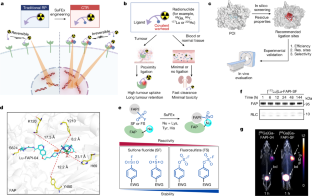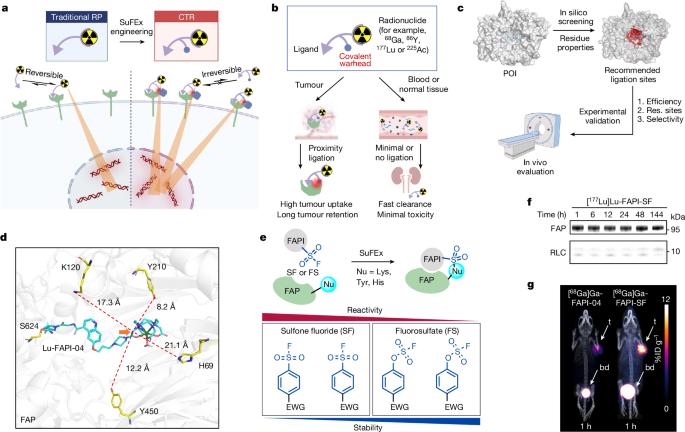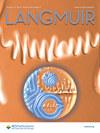共价靶向放射性配体可增强放射性核素治疗效果
IF 3.7
2区 化学
Q2 CHEMISTRY, MULTIDISCIPLINARY
引用次数: 0
摘要
放射性核素靶向治疗是通过放射性药物将强效放射性核素输送到肿瘤进行局部照射,这种治疗方法解决了尚未满足的临床需求,改善了癌症患者的治疗效果1,2,3,4。治疗性放射性药物必须既能持续靶向肿瘤,又能快速从健康组织中清除,这仍然是一项重大挑战5,6。选择性地将放射性药物固定在肿瘤靶蛋白上的靶向连接策略将是理想的解决方案。在这里,我们在放射性药物上安装了一种基于硫(VI)氟化物交换(SuFEx)化学的连接体,以防止过快的肿瘤清除。当设计的放射性药物与肿瘤特异性蛋白结合时,该系统会发生结合到连接的转变,并通过 "点击 "SuFEx 反应与酪氨酸残基轻松结合。将这一策略应用于成纤维细胞活化蛋白(FAP)抑制剂(FAPI)时,80%以上的成纤维细胞活化蛋白与该蛋白共价结合,并且在六天内几乎没有解离。在小鼠体内,SuFEx 工程化的 FAPI 对肿瘤的吸收率比原来的 FAPI 高出 257%,对肿瘤的保留率提高了 13 倍。健康组织中的摄取很快就被清除了。在一项试验性成像研究中,与其他方法相比,这种方法能发现更多癌症患者的肿瘤病灶。SuFEx 改造的 FAPI 还成功实现了β和α放射性核素靶向治疗,使小鼠的肿瘤几乎完全消退。另一种针对前列腺特异性膜抗原(PSMA)的 SuFEx 工程放射性配体也显示出更强的疗效。考虑到有可能与SuFEx弹头连接的蛋白质范围很广,也许有可能将这一策略应用于其他癌症靶点。本文章由计算机程序翻译,如有差异,请以英文原文为准。


Covalent targeted radioligands potentiate radionuclide therapy
Targeted radionuclide therapy, in which radiopharmaceuticals deliver potent radionuclides to tumours for localized irradiation, has addressed unmet clinical needs and improved outcomes for patients with cancer1–4. A therapeutic radiopharmaceutical must achieve both sustainable tumour targeting and fast clearance from healthy tissue, which remains a major challenge5,6. A targeted ligation strategy that selectively fixes the radiopharmaceutical to the target protein in the tumour would be an ideal solution. Here we installed a sulfur (VI) fluoride exchange (SuFEx) chemistry-based linker on radiopharmaceuticals to prevent excessively fast tumour clearance. When the engineered radiopharmaceutical binds to the tumour-specific protein, the system undergoes a binding-to-ligation transition and readily conjugates to the tyrosine residues through the ‘click’ SuFEx reaction. The application of this strategy to a fibroblast activation protein (FAP) inhibitor (FAPI) triggered more than 80% covalent binding to the protein and almost no dissociation for six days. In mice, SuFEx-engineered FAPI showed 257% greater tumour uptake than did the original FAPI, and increased tumour retention by 13-fold. The uptake in healthy tissues was rapidly cleared. In a pilot imaging study, this strategy identified more tumour lesions in patients with cancer than did other methods. SuFEx-engineered FAPI also successfully achieved targeted β- and α-radionuclide therapy, causing nearly complete tumour regression in mice. Another SuFEx-engineered radioligand that targets prostate-specific membrane antigen (PSMA) also showed enhanced therapeutic efficacy. Considering the broad scope of proteins that can potentially be ligated to SuFEx warheads, it might be possible to adapt this strategy to other cancer targets. Radiopharmaceuticals engineered with click chemistry to selectively bind to tumour-specific proteins can be used to successfully target tumour cells, boosting the pharmacokinetics of radionuclide therapy and improving tumour regression.
求助全文
通过发布文献求助,成功后即可免费获取论文全文。
去求助
来源期刊

Langmuir
化学-材料科学:综合
CiteScore
6.50
自引率
10.30%
发文量
1464
审稿时长
2.1 months
期刊介绍:
Langmuir is an interdisciplinary journal publishing articles in the following subject categories:
Colloids: surfactants and self-assembly, dispersions, emulsions, foams
Interfaces: adsorption, reactions, films, forces
Biological Interfaces: biocolloids, biomolecular and biomimetic materials
Materials: nano- and mesostructured materials, polymers, gels, liquid crystals
Electrochemistry: interfacial charge transfer, charge transport, electrocatalysis, electrokinetic phenomena, bioelectrochemistry
Devices and Applications: sensors, fluidics, patterning, catalysis, photonic crystals
However, when high-impact, original work is submitted that does not fit within the above categories, decisions to accept or decline such papers will be based on one criteria: What Would Irving Do?
Langmuir ranks #2 in citations out of 136 journals in the category of Physical Chemistry with 113,157 total citations. The journal received an Impact Factor of 4.384*.
This journal is also indexed in the categories of Materials Science (ranked #1) and Multidisciplinary Chemistry (ranked #5).
 求助内容:
求助内容: 应助结果提醒方式:
应助结果提醒方式:


